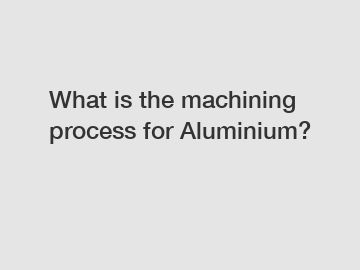Nov. 28, 2023
Minerals
What is the Machining Process for Aluminium?
Aluminium is a popular material that is extensively used in various industries due to its excellent properties such as lightweight, durability, and corrosion resistance. The machining process for aluminium involves several steps to transform a raw aluminium piece into a finished product. In this article, we will explore the machining process for aluminium, its benefits, and some applications.
1. Planning and Design .

The first step in the machining process for aluminium is to plan and design the desired product. This involves determining the dimensions, specifications, and tolerances required for the final aluminium piece. It is crucial to have a clear idea of the design at this stage to ensure a smooth machining process.
2. Selection of Tools .
Once the design is finalized, the next step is selecting the appropriate tools for machining aluminium. High-speed steel (HSS) or carbide cutting tools are commonly used due to their ability to withstand the high temperatures generated during the machining process. The selection of cutting speeds, feeds, and depths of cut is also vital to achieve the desired outcome.
3. Cutting and Shaping .
The cutting and shaping of aluminium is typically done using CNC (Computer Numerical Control) machines. CNC machines provide high precision and accuracy, allowing for complex shapes to be created. During this step, the aluminium piece is secured on the machine bed, and the cutting tool removes the excess material to attain the desired shape and dimensions.
4. Deburring and Surface Treatment .
After the cutting and shaping process, the aluminium piece may have sharp edges or burrs. Deburring is a crucial step to remove these imperfections and ensure smooth edges and surfaces. Various methods like tumbling, sanding, grinding, or using deburring tools can be employed for this purpose. Further surface treatments such as anodizing, polishing, or coating can be applied to enhance the appearance and protect the aluminium from corrosion.
5. Quality Inspection .
Once the machining process is complete, the aluminium piece undergoes a thorough inspection to ensure it meets the required specifications. This involves measuring the dimensions, checking for any defects, and verifying the surface finish. Quality inspection is essential to maintaining high standards and ensuring the final product's integrity.
Benefits of Machining Aluminium .
The machining process for aluminium offers several benefits, making it a preferred choice in many industries. Firstly, aluminium is lightweight, which allows for easier handling and transportation. Secondly, its excellent corrosion resistance ensures that the final product will withstand harsh environmental conditions. Additionally, aluminium can be easily machined into various shapes and sizes, making it highly versatile.
Applications of Machined Aluminium .
Machined aluminium is widely used in industries such as aerospace, automotive, electronics, construction, and manufacturing. In the aerospace industry, aluminium components are used in aircraft frames, engine parts, and wings due to their lightweight and high strength-to-weight ratio. In the automotive industry, machined aluminium parts are utilized in engines, transmissions, and body structures for improved fuel efficiency. Other applications include electronics housings, building facades, and consumer goods.
Conclusion .
The machining process for aluminium involves careful planning, selection of tools, cutting and shaping, deburring, and quality inspection. With its numerous benefits and versatility, machined aluminium finds application in various industries. If you are interested in leveraging the advantages of aluminium machining for your specific needs, do not hesitate to contact us.
(Contact us for more information on aluminium machining or to discuss your specific requirements.).
For more information, please visit profile precision extrusions, cnc extrusion, china precision aluminum extrusion factory.
Previous: Silica Fume Supplier Guide: How to Choose the Right Partner for Your Project
Next: What is the manufacturing method of fireclay refractory?
If you are interested in sending in a Guest Blogger Submission,welcome to write for us!
All Comments ( 0 )